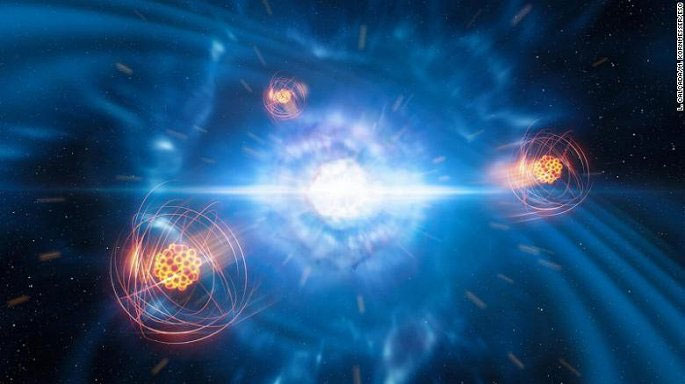New discovery: Collisions of neutron stars produce heavy elements of strontium
Astronomers have discovered the collision of two neutron stars in 2017 creating a heavy element of strontium alongside gold, lead and platinum.
Two years ago, astronomers observed the collision of two neutron stars for the first time. This tremendous explosion not only produced gravitational waves and light, but also produced heavy elements such as gold, platinum and lead. These elements are scattered in the universe from a kilonova explosion (similar to the supernova explosion).

Image illustrating the collision of 2 neutron stars.(Photo: CNN)
Scientists have even discovered strontium - a heavy element created after the neutron star collision . This finding strengthens the evidence that neutron star clashes could produce heavy elements found throughout the universe.
Neutron stars are the smallest objects in the universe with a diameter equal to the city of Chicago or Atlanta (USA). They are what remains of supernova explosions but are extremely dense with masses even greater than the Sun.
Imagine the Sun compressed into a size the size of a city, you will see how dense and heavy neutron stars are, and also how horrible their collisions will be.
The new discovery of this neutron star collision has just been published in the journal Nature on October 23, 2019.
"By analyzing the 2017 data of the neutron star merger, we discovered the presence of another heavy element in this fireball, strontium. That reinforces the perception. that neutron star collisions can make this element in the universe, "said Darach Watson, head of research at the University of Copenhagen in Denmark.
Strontium is used in the process of making fireworks and is heavier than iron.
Astronomers have been studying how these heavy elements have been created for decades.
"This is the final stage in decades of quest for the origin of these elements. We all know the process of creating these elements is mostly in primitive stars, in explosions. supernovas or in the outer layers of old stars.
However, so far, we do not know the location of this final stage, commonly known as the fast neutron capture process when it forms heavy elements in the periodic table of elements. " Watson said.
During fast neutron capture, the neutrons are trapped extremely fast by atomic nuclei. Besides the speed factor, heavy elements like strotium also need extremely hot environments filled with free neutrons to form. This is a natural process that occurs only in such harsh environments and it takes less than 1 second.
Because the neutron star collision just happened in 2017, astronomers are still figuring out what happened in this process and what was made later.
- Roscosmos announces the sound of neutron stars
- The mysterious mystery surrounding the strange neutron star is intriguing
- The original gold smelter in the universe
- Dwarf galaxies contain all of gold, silver and platinum
- What is a Neutron Star?
- Roscosmos announces the sound of neutron stars
- New discovery about the formation of neutron stars
- Gravitational waves bring people to an unprecedented phenomenon in astronomical history
- Supernovae do not produce the largest element
- Finding strange stars Neutron is twice as massive as the Sun.
- Detecting unprecedented neutron stars, challenging the physical limit
- The discovery of the neutron star collision is 'breakthrough' of 2017
- The source of large energy radiation from the Crab Nebula
- Discover the source of gravitational waves from neutron stars
 Van Allen's belt and evidence that the Apollo 11 mission to the Moon was myth
Van Allen's belt and evidence that the Apollo 11 mission to the Moon was myth The levels of civilization in the universe (Kardashev scale)
The levels of civilization in the universe (Kardashev scale) Today Mars, the sun and the Earth are aligned
Today Mars, the sun and the Earth are aligned The Amazon owner announced a secret plan to build a space base for thousands of people
The Amazon owner announced a secret plan to build a space base for thousands of people